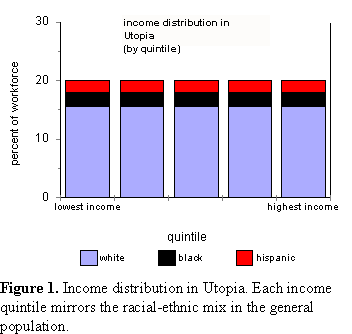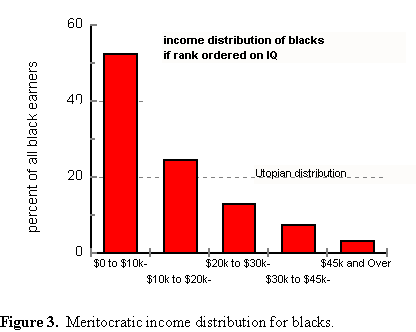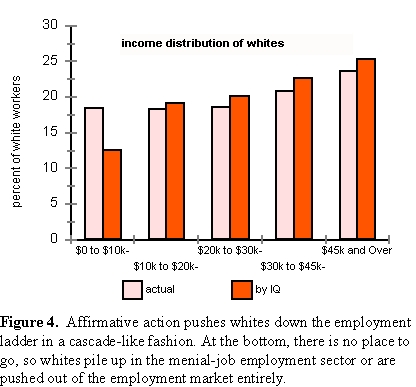 December 1999 |
|
|
 December 1999 |
|
|
AFFIRMATIVE
ACTION:
Decades have elapsed since the major civil rights laws were passed, yet we still find some minority groups lagging behind. Often achieving well politically, blacks in particular remain far down the economic ladder. Centuries of slavery followed by persistent discrimination and white racism are the usual suspects. More exotic explanations include lowered expectations, reluctance to act white, etc. But since none of this affects g-loaded test scores where the black-white difference has remained remarkably constant, some principle of parsimony should direct us elsewhere for answers. Parsimony, however, is not in the legislator's lexicon; nor is it part of the system of rationalizations we call justice. So we are left with implausible speculations to justify the system of race and sex-based preferences we call affirmative action. Affirmative action is not free. No matter how large or
small a business is, it is vulnerable to complaints of discrimination by
applicants, employees and former employees. In the interest of the bottom
line, employers invariably capitulate. The consequences of not conforming
are more costly. Brimelow and Spencer in When Quotas Replace Merit,
Everybody Suffers, Forbes, February 15, 1993, assert that the
greatest cost of affirmative action results from not being able to choose
the best economic alternatives. They estimate this cost alone at $236 billion
for 1991. Administrative costs associated with affirmative action add another
$100 billion or so per year. Most other estimates also put the annual bill
for affirmative action in the two to four hundred-billion dollar ballpark.
Whenever someone gets preferential access to a job or a promotion because of his race or ethnicity, someone else of a different race or ethnicity gets displaced. In the U.S., the displaced person is usually a non-Hispanic white. The result is an income transfer from whites to "preferred" minorities. We call it the Robin Hood effect. We have assessed its size by using a simple device: the correlation of income and IQ. From this relation we can construct a profile of the workforce as it would exist in a meritocracy, The Income-IQ Nexus
Then there is luck. A person must be available when an opportunity pops up. Geography may be a factor. New Yorkers have more opportunity to earn well than West Virginians. Sometimes, ties to family and geography will constrain people from seeking or taking the best jobs. Lastly, other qualities like personality, work habits, ethical or moral values, to name a few, factor into the ability to earn. All these and more produce fluctuations in the income-IQ curve, a problem we need to solve. By dividing the workforce into broad ranges, say quintiles,
we can virtually eliminate the fluctuations. Each quintile will contain
millions of earners. Dentists and professors, with rather different incomes,
will fall into the same income quintile. If IQ correlates well with income,
it will correlate almost perfectly with the income of a work force so partitioned.
1) What would income distribution by race and ethnicity look like in Utopia?Utopian distribution. In Utopia, races and ethnic groups are indistinguishable from one another except for obvious physical characteristics. Utopia is the prevailing construct in the West. It is the premise upon which affirmative action is built. In Utopia, each quintile will be populated in proportion to the racial-ethnic composition of the workforce at large. Each quintile will be racially and ethnically indistinguishable from any other (Figure 1).  The Utopian justification of affirmative action is illustrated by the testimony of Representative Sheila Jackson Lee before the Subcommittee on the Constitution, Committee on the Judiciary, U.S. House of Representatives, December 7, 1995. Speaking of women, roughly 50 percent of the population, she argued:
Meritocratic distribution. The IQ-income nexus allows us to estimate the income distribution in a meritocracy. First divide the labor force into quintiles according to income. Imagine the quintiles to be boxes. Each box holds 20 percent of the workforce. From the pool of all earners, find the most intelligent and throw him into the highest income box. Locate the next smartest worker and throw him in for company. Proceed down the line, each time choosing the most intelligent of those left, until the highest-income box is filled. Then fill the next highest-income box in the same way. When it is filled, go to the next box and so on until all five boxes are filled. In the end the highest IQ workers will populate the highest-income quintile, and so on down the line. To generate the rank ordering of the workforce on IQ, required to construct the meritocratic distribution, we used mean IQ differences from the National Longitudinal Study of Youth (NLSY): 1.21 SD for the white-black difference, and 0.93 SD for the white-Hispanic difference. The mathematical procedure for populating the quintiles is described in an Appendix. Actual distribution. The U.S. Government compiles impressive amounts of social data. Virtually every social statistic is recorded somewhere in its archives. We used data from the Annual Demographic Survey (ADS) to construct the quintile distribution. The survey is jointly sponsored by the Bureau of Labor Statistics and the Bureau of the Census. It tabulates income by race, ethnicity, sex and age. We used ADS data of 1997. The ADS classifies workers as black, white, Hispanic, and white-not-Hispanic. Since Hispanics can be of any race, we formed the classification Hispanic-white by subtracting the white-not-Hispanic data from the white data. Ultimately, we formed three non-overlapping groups: black, Hispanic-white, and non-Hispanic white. For simplicity, from now on we refer to these groups as black, Hispanic and white, respectively. All but a few percent of Americans who earned income in 1997 were included in our analysis. (The ADS data of 1997 did not include Asian Americans.) Income in the ADS is broken into $2,500 bins: $0 to $2,499, $2,500 to $4,999, and so on through $97,500 to $99,999. Finally, the last bin is for earners making $100,000 or more. The ADS breaks down the population of each bin by race, ethnicity, sex and age. We included in our sample only workers between the ages of 25 and 64, the mainstream of full-timers. They numbered 126,362,000 in 1997. Starting at the low-income end, we added earners in adjacent
bins until we got as close as possible to 20 percent of the workforce.
In this way we partitioned the workforce into near-quintiles, each containing
20±1 percent of all workers. By using near-quintiles instead of
true quintiles, we sacrificed nothing but symmetry. Near-quintiles flatten
the fluctuations as well as true quintiles. Table 1 summarizes the partition.
Results Table 2 compares, for each racial/ethnic group, actual and meritocratic distributions of income. Table 3 does the same but uses percentages rather than numbers of workers.
Analysis
 Figure 3 shows how blacks would fare in a meritocracy,
where a very different picture emerges.
 Comparison of Figures 2 and 3 shows that blacks have gained enormously under affirmative action. The eccentricities of their income distribution have been compressed toward the Utopian ideal. The effect is dramatic. Left to a free market, more than half (52.5 percent) of black full-time workers would have earned less than $10,000 in 1997, not surprising for a group with half its members under 85 IQ. Remarkably, affirmative action reduced the number of blacks in this lowest-income quintile to less than 25 percent. Similar, but somewhat less dramatic gains have been made by Hispanics. In a free market, about 41 percent of Hispanics would be in the $0 to $9,999 bracket. Affirmative action has reduced this to about 27 percent. Too good to be true? That depends on your philosophical perspective. This is a zero-sum game. To reduce black and Hispanic representation in low-income brackets and increase it in high-income brackets, whites must be displaced. The size of the Robin Hood effect. The income lost to whites
is easily assessed. The number of whites displaced into or out of a given
quintile is the difference between the white quintile population in a meritocracy
and that actually observed. The number of displaced whites times the midpoint
income of a quintile approximates the lost income for that quintile. The
total income lost is the sum of losses over the 5 quintiles. Table 4 illustrates
the calculation.
In 1997, because of affirmative action, about $192 billion in income was transferred from whites to preferred minorities. If we perform precisely the same calculation for blacks and Hispanics, we can break down the $192 billion into the amounts gained by each group. We find that $144.3 billion was transferred to blacks and $47.5 billion to Hispanics. Dividing these gains by the respective numbers of black and Hispanic workers, we can compute their average annual income enhancement. In 1997, on average a black was subsidized to the tune of about $9,400; a Hispanic gained an average of about $3,900. The cost of these subsidies was spread over 98,782,000 white workers who suffered an average loss of about $1,900 to pay the bill. The cascade effect. The net displacement of whites by minorities
is not uniformly spread across the quintiles. When high-earning whites
are displaced down the employment ladder, they displace other whites downward
by exerting pressure on the rung below. The effect is like a cascade. At
the bottom there is no rung left. Low IQ whites, who in an affirmative
action-free marketplace would be competitive in the $10,000 to $20,000
bracket, now pile up in the lowest-income quintile. Although affirmative
action affects every white, the largest number affected are the least intelligent
and competitive. Figure 4 illustrates the cascade effect.
 Summary
APPENDIX. Rank Order Filling of n-tiles Suppose we wish to fill NS slots in rank order on some property, x, from a population that consists of M groups. Let the ith group contain Ni members. Choose one group as the reference group, with a normalized distribution of the property, P(x). Let the distribution function of the ith group differ from P(x) by a translation, Δi, along the property axis. In Women
and Minorities in Science, we showed that under these assumptions
the following relation is satisfied.
 Members of the population possessing a value of the property greater than or equal to λ make the cutoff and fill one of the slots. The value of λ is determined in practice by numerical solution of (1). For the case of filling successive n-tiles from
the top down by rank order on the selected property, we can use a generalization
of (1):
 |
||||||||||||||||||||||||||||||||||||||||||||||||||||||||||||||||||||||||||||||||||||||||||||||||||||||||||||||||||||||||||||||||||||||||||||||||||||||||||||||||||||||||||||||||||||||||||||||||||||||||||||||||||||||||||||||||||||||||||||||||||